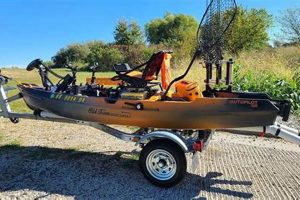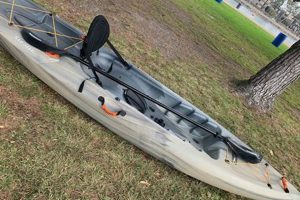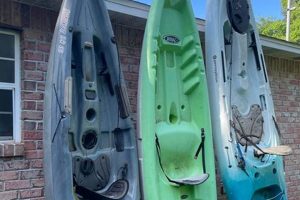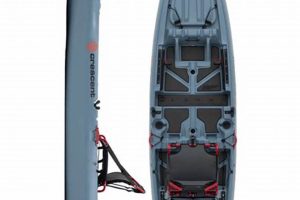Top-rated kayaks available for purchase represent a significant segment of the recreational boating market. This category encompasses a wide range of vessels, from inflatable and recreational kayaks to touring and fishing models, catering to diverse paddling styles and experience levels. Considering factors such as hull design, material construction, intended use, and budget is crucial in selecting a suitable kayak.
Acquiring a high-quality kayak provides access to numerous on-water activities, including fishing, exploring coastlines and waterways, fitness paddling, and simply enjoying nature. The selection of an appropriate craft ensures safety, comfort, and performance, enhancing the overall paddling experience. Historically, kayak designs have evolved from traditional skin-on-frame constructions used by indigenous peoples to the modern, technologically advanced materials and designs available today, offering users improved durability, stability, and versatility.
This article will delve into key considerations for choosing a kayak, including hull types, materials, features, and popular brands, empowering readers to make informed decisions based on their individual needs and preferences. Topics covered will include discussions of sit-on-top versus sit-inside kayaks, inflatable versus rigid hull options, and essential accessories for enhancing safety and enjoyment on the water.
Tips for Selecting a Kayak
Choosing a kayak requires careful consideration of various factors to ensure the vessel aligns with individual needs and paddling goals. The following tips provide guidance for navigating the selection process.
Tip 1: Define the intended use. Consider where and how the kayak will be used. Calm lakes and rivers require different kayak characteristics than ocean paddling or whitewater navigation.
Tip 2: Evaluate hull types. Different hull designs offer varying degrees of stability, maneuverability, and tracking. Flat hulls offer stability, while rounded hulls enhance maneuverability. V-shaped hulls improve tracking but can feel less stable.
Tip 3: Consider materials. Kayaks are constructed from various materials, including polyethylene, fiberglass, and composites. Polyethylene offers durability, while fiberglass and composites provide lighter weight and enhanced performance, but often at a higher cost.
Tip 4: Assess seating and comfort. Proper seating and back support are crucial for comfort, especially during longer paddling trips. Adjustable features allow customization for individual preferences.
Tip 5: Determine the appropriate length and width. Longer kayaks track better in a straight line, while shorter kayaks are more maneuverable. Wider kayaks offer greater stability but can be slower.
Tip 6: Research reputable brands and models. Reading reviews and comparing different brands helps identify manufacturers known for quality construction and performance.
Tip 7: Set a budget. Kayak prices vary significantly. Establishing a budget helps narrow down the options and prioritize desired features.
Tip 8: Consider storage and transportation. Think about how the kayak will be stored and transported. Inflatable kayaks offer portability, while rigid kayaks require appropriate storage space and transportation solutions.
By carefully evaluating these factors, individuals can select a kayak that optimally suits their needs, ensuring a safe, comfortable, and enjoyable paddling experience.
The subsequent sections of this article will further explore specific kayak types and features, providing a deeper understanding of the available options within the market.
1. Hull Type
Hull type significantly influences a kayak’s performance characteristics, playing a crucial role in determining its suitability for specific water conditions and paddling styles. Understanding the nuances of various hull designs is essential for selecting a kayak that aligns with individual needs and intended use. This section explores prominent hull types and their implications for optimal kayak selection.
- Flat Hull
Flat hulls offer exceptional primary stability, making them ideal for calm waters such as lakes and slow-moving rivers. Their wide, flat bottoms provide a stable platform, especially beneficial for beginners or activities like fishing and photography. However, flat hulls tend to be slower and less maneuverable than other hull types, making them less suitable for covering long distances or navigating challenging conditions. Recreational kayaks often feature flat hulls.
- Rounded Hull
Rounded hulls excel in maneuverability, making them well-suited for navigating rivers, rock gardens, and surf zones. Their curved bottoms allow for quick turns and responsive handling. However, rounded hulls offer less initial stability than flat hulls, potentially requiring more experience and balance from the paddler. Whitewater kayaks and some touring kayaks utilize rounded hulls.
- V-Shaped Hull
V-shaped hulls prioritize tracking and speed, efficiently cutting through the water and maintaining a straight course. They are favored for touring and sea kayaking, where covering long distances efficiently is essential. However, V-shaped hulls offer less initial stability than flat or rounded hulls, making them more susceptible to tipping. Sea kayaks and touring kayaks often utilize V-shaped hulls.
- Pontoon Hull
Pontoon hulls offer exceptional stability due to their multiple contact points with the water. They are commonly found in recreational kayaks designed for maximum stability and are suitable for beginners or those seeking a stable platform for fishing or photography. While remarkably stable, pontoon hulls can be less maneuverable and slower than other hull designs.
Selecting the appropriate hull type is paramount for maximizing performance and enjoyment on the water. Careful consideration of intended use, desired stability, and maneuverability needs will guide the selection process towards the optimal kayak hull design, contributing to a safe and fulfilling paddling experience. Understanding the interplay between hull type and other kayak features, such as length and width, further refines the selection process and ensures a well-informed purchase decision.
2. Material
Kayak construction materials directly influence performance, durability, and cost, making material selection a critical factor when seeking top-tier kayaks. Material properties affect weight, impact resistance, maintenance requirements, and overall lifespan. Understanding the characteristics of various kayak materials empowers informed purchasing decisions aligned with individual paddling needs and budget constraints.
- Polyethylene (PE)
Polyethylene is the most common kayak construction material due to its durability, affordability, and impact resistance. Rotational molding creates a seamless, robust hull capable of withstanding impacts and abrasions. PE kayaks require minimal maintenance and offer excellent value, making them suitable for recreational use and rental fleets. However, PE is heavier than other materials, impacting portability and performance.
- Fiberglass
Fiberglass kayaks offer a balance of performance and affordability. Layering fiberglass cloth with resin creates a stiff, lightweight hull that responds efficiently to paddle strokes. Fiberglass kayaks offer better speed and maneuverability compared to PE kayaks, making them suitable for touring and sea kayaking. However, fiberglass requires more careful handling and maintenance to prevent scratches and cracks.
- Composite Materials (Kevlar, Carbon Fiber)
Composite materials like Kevlar and carbon fiber represent the premium segment of kayak construction. These materials offer exceptional strength-to-weight ratios, resulting in lightweight, high-performance kayaks ideal for racing and long-distance touring. Composite kayaks provide superior speed, efficiency, and responsiveness but come at a significantly higher price point and require specialized maintenance.
- Inflatable Kayaks (PVC, Hypalon, Nitrylon)
Inflatable kayaks utilize durable, flexible materials such as PVC, Hypalon, or Nitrylon. These materials allow for compact storage and easy transport. While generally less durable than rigid kayaks, advancements in inflatable technology have led to increased durability and performance, making them suitable for recreational paddling and exploring calmer waters. Material choice influences the inflatable kayak’s weight, resistance to punctures, and overall lifespan.
Material selection significantly influences a kayak’s suitability for specific paddling disciplines and environments. Evaluating material properties alongside hull design, intended use, and budget constraints ensures a well-informed purchase decision. Ultimately, the ideal kayak material depends on the individual’s paddling style, performance expectations, and storage/transportation needs.
3. Intended Use
A kayak’s intended use is paramount in determining its suitability among available options. Matching the kayak’s design and features to the specific paddling environment and activity ensures optimal performance, safety, and enjoyment. Understanding diverse paddling disciplines and their corresponding kayak requirements is crucial for navigating the selection process effectively.
- Recreational Paddling
Recreational kayaking typically involves calm water environments such as lakes, slow-moving rivers, and protected bays. Kayaks designed for recreational use prioritize stability and comfort, often featuring wider hulls, shorter lengths, and user-friendly features like adjustable seats and ample storage. Sit-on-top kayaks are popular choices for recreational paddling due to their ease of entry and exit. Inflatable kayaks also cater to this segment, offering portability and convenience.
- Touring/Sea Kayaking
Touring and sea kayaking involve longer journeys across open water, often exposed to varying conditions. Kayaks designed for these disciplines prioritize tracking, speed, and storage capacity. Longer, narrower hulls with V-shaped or rounded bottoms enhance efficiency and maneuverability in challenging conditions. Sea kayaks often incorporate features like rudders or skegs for improved tracking and control in wind and currents. Storage compartments accommodate gear and supplies for multi-day expeditions.
- Fishing Kayaks
Fishing kayaks prioritize stability, specialized features, and storage solutions tailored to angling needs. Stable hulls, often flat or pontoon-style, provide a secure platform for casting and reeling. Features like rod holders, tackle storage compartments, and anchor trolleys enhance the fishing experience. Sit-on-top designs offer ease of movement and access to gear. Specialized fishing kayaks may include features like livewells or pedal-powered propulsion systems.
- Whitewater Kayaking
Whitewater kayaking involves navigating rivers and rapids, requiring specialized kayaks designed for maneuverability, durability, and safety in turbulent conditions. Short, rounded hulls with high rocker profiles enable quick turns and responsiveness in fast-flowing water. Whitewater kayaks typically incorporate features like thigh straps and adjustable footrests for enhanced control and stability. Durable construction materials, such as polyethylene or composite materials, withstand impacts and abrasions encountered in dynamic whitewater environments.
Careful consideration of intended use guides the selection process toward kayaks optimized for specific paddling activities. Aligning the kayak’s design, features, and construction materials with the intended environment and paddling style ensures a safe, efficient, and enjoyable experience on the water. Evaluating intended use alongside other factors such as budget, user experience, and storage/transportation needs contributes to a comprehensive and informed purchase decision.
4. Brand Reputation
Brand reputation plays a significant role in the kayak market, influencing consumer perceptions of quality, performance, and reliability. Established brands often command higher price points based on their history of innovation, customer service, and product durability. Understanding how brand reputation intersects with the “best kayaks for sale” concept requires examining several key facets.
- Innovation and Design
Reputable brands frequently invest in research and development, leading to innovations in hull design, materials, and features. This commitment to innovation often translates to improved performance, comfort, and specialized functionalities catering to specific paddling disciplines. For example, brands known for their whitewater kayaks may introduce advanced hull designs for enhanced maneuverability in challenging rapids, while brands specializing in touring kayaks might prioritize lightweight materials and efficient tracking capabilities.
- Manufacturing Quality and Materials
Brand reputation is closely tied to manufacturing quality and material selection. Established brands often adhere to stringent quality control processes and utilize premium materials, contributing to enhanced durability, longevity, and overall product performance. This commitment to quality reinforces consumer trust and justifies higher price points associated with reputable brands. For instance, a brand known for using high-grade polyethylene in its recreational kayaks might garner a reputation for producing robust, impact-resistant boats suitable for demanding conditions.
- Customer Service and Warranty
Customer service and warranty policies significantly contribute to brand reputation. Responsive customer support, efficient warranty claims processing, and readily available replacement parts enhance consumer confidence and contribute to a positive brand image. A brand’s commitment to addressing customer concerns and honoring warranty obligations reinforces its reputation for reliability and trustworthiness.
- Resale Value
Kayaks from reputable brands often retain their value better in the resale market. This stronger resale value can be attributed to factors such as perceived quality, durability, and brand recognition. Consumers considering reselling their kayaks in the future may find that investing in a reputable brand mitigates potential depreciation, making it a financially sound decision in the long term.
Ultimately, brand reputation serves as a valuable indicator of quality, performance, and reliability when navigating the “best kayaks for sale” landscape. While price point often correlates with brand reputation, considering the interplay between innovation, manufacturing quality, customer service, and resale value offers a more comprehensive understanding of a brand’s overall value proposition. By evaluating these factors, consumers can make informed purchasing decisions aligned with their individual needs, budget constraints, and long-term paddling goals.
5. Price Point
Price point exerts a substantial influence on consumer decisions when seeking top-tier kayaks. While “best” does not inherently equate to “most expensive,” price often reflects material quality, features, and brand reputation. Understanding the relationship between price and value is crucial for navigating the kayak market effectively. A higher price point often correlates with advanced materials like carbon fiber or Kevlar, offering lighter weight and enhanced performance characteristics. Conversely, more affordable kayaks constructed from polyethylene may prioritize durability and impact resistance over lightweight performance. Inflatable kayaks offer an entry-level option, providing portability and convenience at lower price points compared to rigid alternatives. For example, a high-end fishing kayak might include integrated electronics, specialized storage compartments, and a pedal-powered propulsion system, justifying a higher price tag compared to a basic recreational kayak. Conversely, a beginner paddler might prioritize affordability and durability, opting for a less expensive polyethylene model suitable for calm water excursions.
Analyzing price point necessitates considering the intended use and desired features. A recreational paddler seeking a stable platform for occasional use might find excellent value in a mid-range kayak offering a balance of durability and comfort. However, a dedicated angler seeking specialized features and enhanced stability might justify the investment in a higher-priced fishing kayak tailored to their specific needs. Similarly, a serious touring kayaker prioritizing lightweight performance and efficient tracking might opt for a premium composite kayak despite the higher cost. Recognizing that price point often aligns with specific material choices, construction techniques, and feature sets empowers informed purchasing decisions. For instance, a budget-conscious buyer might prioritize a durable polyethylene kayak over a lighter fiberglass model, accepting a trade-off in weight for increased impact resistance and affordability.
Ultimately, evaluating price point in conjunction with intended use, desired features, and brand reputation enables consumers to identify the “best” kayak aligned with their individual needs and budget constraints. Discerning value within various price brackets requires careful consideration of material quality, construction techniques, features, and brand reputation. Recognizing that the “best” kayak is not necessarily the most expensive, but rather the one that optimally balances performance, features, and price according to individual paddling requirements, empowers informed purchasing decisions and contributes to a satisfying on-water experience.
6. User Comfort
User comfort significantly influences paddling enjoyment and performance, representing a crucial factor when considering the “best kayaks for sale.” Optimal comfort enhances endurance, reduces fatigue, and promotes a positive on-water experience. Several key facets contribute to user comfort, each playing a vital role in determining a kayak’s suitability for individual paddlers.
- Seat Design and Adjustability
Seat design significantly impacts comfort, especially during longer paddling trips. Ergonomic designs that provide adequate lumbar support and cushioning minimize strain and pressure points. Adjustable features, such as backrest angle and seat height, allow customization for individual body types and preferences. High-end kayaks often feature breathable mesh seating surfaces for enhanced ventilation and comfort in warm weather. A well-designed, adjustable seat contributes significantly to overall paddling enjoyment and reduces the risk of discomfort or fatigue.
- Cockpit Dimensions and Layout
Cockpit dimensions and layout influence comfort and control. A properly sized cockpit provides adequate legroom and freedom of movement without compromising stability. Kayaks designed for smaller paddlers typically feature smaller cockpits, while larger paddlers benefit from more spacious designs. The cockpit layout should provide easy access to essential gear and allow for comfortable entry and exit. Consideration of cockpit dimensions is particularly important for individuals with physical limitations or specific mobility needs.
- Footrest Systems and Adjustability
Adjustable footrests provide essential leverage and control, contributing to efficient paddling and overall comfort. Proper foot placement enhances stability and allows paddlers to engage their core muscles effectively. Adjustable footrest systems accommodate varying leg lengths and paddling styles, ensuring optimal biomechanics and reducing strain. Secure and comfortable footrests contribute to efficient power transfer and minimize fatigue during extended paddling sessions.
- Backrests and Lumbar Support
Adequate back support is essential for maintaining proper posture and preventing back pain, particularly during long paddling trips. Ergonomically designed backrests with adjustable lumbar support provide customized comfort and minimize strain on the lower back. High-quality backrests contribute to a more enjoyable and less fatiguing paddling experience, allowing individuals to focus on the scenery and the activity itself rather than discomfort.
Prioritizing user comfort enhances the overall paddling experience and contributes significantly to the “best kayaks for sale” designation. A comfortable kayak promotes efficient paddling, reduces fatigue, and enhances enjoyment on the water. Evaluating seat design, cockpit dimensions, footrest systems, and backrest features ensures a well-informed purchase decision aligned with individual needs and preferences. Ultimately, a comfortable kayak enables paddlers to fully appreciate the sport and explore waterways with greater ease and enjoyment.
Frequently Asked Questions
This section addresses common inquiries regarding the selection and purchase of optimal kayaks.
Question 1: What constitutes the “best” kayak?
The “best” kayak is subjective, depending on individual needs, paddling style, and intended use. Factors such as hull type, material, features, and budget influence the optimal choice for a given paddler.
Question 2: How does one determine the appropriate kayak size?
Kayak sizing depends on the paddler’s weight, height, and intended use. Manufacturers provide size charts and weight capacity guidelines to assist in selecting the appropriate kayak dimensions.
Question 3: What are the primary differences between sit-on-top and sit-inside kayaks?
Sit-on-top kayaks offer enhanced stability and ease of entry/exit, making them suitable for recreational paddling and warmer climates. Sit-inside kayaks offer greater protection from the elements and enhanced control in challenging conditions.
Question 4: What are the key considerations when choosing between an inflatable and a rigid kayak?
Inflatable kayaks prioritize portability and storage convenience, while rigid kayaks offer enhanced performance and durability. Material selection, intended use, and storage/transportation logistics influence this decision.
Question 5: How does budget influence kayak selection?
Budget considerations often dictate material choices, features, and brand reputation. Higher-priced kayaks often utilize advanced materials and offer specialized features, while budget-friendly options prioritize durability and affordability.
Question 6: What maintenance is required for different kayak types?
Maintenance requirements vary depending on the kayak’s material. Polyethylene kayaks require minimal maintenance, while fiberglass and composite kayaks necessitate more diligent care to prevent damage. Inflatable kayaks require proper cleaning and storage to maintain their integrity.
Understanding these frequently asked questions provides a foundational understanding for navigating the kayak market and making informed purchase decisions. Careful consideration of individual needs, paddling style, and budget constraints ensures the selection of a kayak optimized for a safe and enjoyable on-water experience.
The subsequent sections of this article will provide in-depth reviews of specific kayak models, further assisting consumers in making informed purchase decisions.
Conclusion
Selecting from the best kayaks available requires careful evaluation of various factors. Hull design, material construction, intended use, and budget considerations all play crucial roles in determining the optimal kayak for individual needs. Prioritizing stability for recreational use, speed and efficiency for touring, specialized features for fishing, or maneuverability for whitewater dictates specific design choices. Material selection influences durability, weight, and price, impacting overall performance and longevity. Balancing these factors within budget constraints empowers informed purchasing decisions.
The kayak market offers diverse options catering to various paddling disciplines and experience levels. Thorough research, consideration of individual needs, and a comprehensive understanding of key features empowers informed decisions. Ultimately, selecting a well-suited kayak unlocks access to diverse waterways and enhances the overall paddling experience, fostering enjoyment and exploration of aquatic environments.






